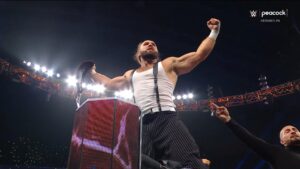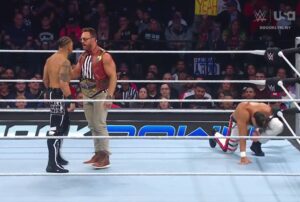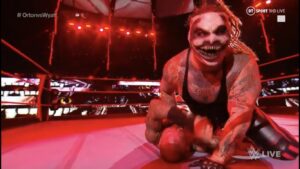When it comes to AEW and their presentation of men and male relationships in storylines and characters, I don’t think the company gets enough credit.
Sports generally are masculine affairs. Traditionally sport is the male domain. Filled with testosterone and emotions that are somewhat more acceptable to show compared to other arenas in life. Ingrained in pro wrestling’s history is machismo. Tough men and big men and strong men.
Men who fight and won’t give up unless pushed to breaking point. They won’t cry. At it’s core its hyper-masculinity. There are plenty of old wrestlers and fans who like it this way.
It’s traditional, it’s safe and it’s how things always have been. Especially given how the world is changing in a way many folks are uncomfortable with, they want things to remain as they are.
AEW on multiple occasions, with various male wrestlers and storylines challenges traditional masculinity. They offer a more modern, diverse, and for some fans, challenging look at traditional masculine values. And at times they take criticism for this as I’ll address later.
They do things differently to WWE and not everyone gets it or enjoys it and that’s fine. Doing something new isn’t always appreciated at the time.
But for me, and likely for many other men out there, seeing a diverse range of male experiences presented in the sport strengthens what I already know is true. Being a man is about being more than a limited set of stereotypes and expectations. It’s about how you handle the struggle.
Anxious Millennial Thirty-Three-Year-Old
I’m British and traditional masculinity is wrapped up in the unspoken stiff upper lip mentality. As a child, I internalized doing things wrong meant I was “wrong”. This led me to seek perfection in everything I did.
The banter of school and rugby culture taught me if the joke hurts then it’s my fault and I should fight back. This taught me to never show weakness.
As a teenager, I got into wrestling during the “Ruthless Aggression” era (primarily SmackDown). I learned from my heroes Kurt Angle, Chris Benoit, and Eddie Guerrero more about being a man.
In hindsight, this seems problematic given the reality that all self-medicated to one degree or another to deal with their pain. Two died young. My favorite of the trio committed murder.
All of the above contributed to my issues with anxiety, imposter syndrome, and other mental health issues. Eventually, I sought support. I talk to family and friends more openly and have received counseling when needed. I learned communication was a strength and not a weakness.
How toxic masculinity has affected my life and others. Toxic masculinity is still a big part of wrestling. I wrote last month about how WWE’s most successful storyline in years, The Bloodline is all about toxic masculinity.
So, when I began watching AEW and I saw a guy like me: blonde, a bit awkward, a former schoolteacher whose whole gimmick was “anxious millennial cowboy,” I took notice.
Overcoming Mental Barriers
Many have called “Hangman” Adam Page the main character of AEW. His arc to becoming the AEW World Champion brought back to wrestling not only the long-term story arc. It also added layers of nuance and exploration of mental health that another AEW wrestler would later display.
Losing to Chris Jericho, Hangman became isolated and estranged from The Elite first by his own doing. Perceiving himself as a weak link, different from his friends, Hangman slowly resisted and pulled away from the group. Like most men, brought up on the belief you’re either a winner or loser,
Hangman felt he was a loser. Although being stuck in his head did not allow him to spot that likewise, his best friends were also experiencing the same issues.
Kenny Omega had a mirroring storyline where “The Best Bout Machine” failed to live up to his potential. This weaved wonderfully into Omega and Hangman’s tag team championship reign.
The Young Bucks likewise lost to Private Party on the first AEW Dynamite and failed to get tag team gold. Viewers could see all four deal differently with their mental health and how Hangman suffered worse.
Comments on being a young boy, the subtly storytelling of the rest of The Elite drinking milk and Hangman drinking more and more booze, the smashed mirror, was all cinematic foreboding. Things when untreated get worse rather than better.
FTR manipulated a fragile Hangman. Page was kicked out of The Elite. Omega ascended and beat Hangman on the way to the top. Hangman’s hero’s journey was about overcoming himself as much as his opponents.
Hangman gained friends (a support system) in The Dark Order. Overcame manipulation from Matt Hardy. Dealt with a loss to Brian Cage before becoming the world champion. The victory was mental as much as physical.
“I am a man!”
The Hangman Page character once he won the World Championship seemed to lose that anxiety. If it was there, it was not signposted like it had been before. If the idea was Hangman was overcompensating for that anxiety with confidence or something else, it was played too subtly.
It’s a mistake AEW seemed to have learned from with Swerve Strickland’s booking as a future world champion recently.
Yet at various points, it returned. Most notably after Jon Moxley knocked Hangman out when challenging for the World Championship in Ohio in October 2022. In the build-up to their Texas Deathmatch at Revolution 2023, the stoic Moxley tried to use what he saw as weakness against Hangman.
Spoke of how he had no time for the luxuries of anxiety or fear. The old school mentality that you just don’t think about these things. As a man, you just deal with this stuff. Let it drip off you like sweat.
Hangman highlighted how he had nothing left to lose, but to counter Moxley’s take, the character talked about mental suffering on an equal level.
“I’m angry. I’m frustrated. I can’t sleep at night. I’m anxious. I’m depressed. The medicine is not working and I am still here because I am a man.”
It legitimized that sense of suffering as being equal to physical pain and more. Highlights that being a man can involve suffering. It involves emotions and feelings that usually we are told to deny.
The medicine doesn’t cure it but being a man is about persistence. It’s getting up when you are knocked out, literally in Page’s case. It’s about effort and trying despite there isn’t an easy answer or cure.
It’s acknowledging that living through suffering is strength.
Making of the Mad King
Eddie Kingston as a man, not just a wrestler, depending on who you ask is either this century’s people’s champion or a slob. When Kingston cuts a promo it cuts differently. Kingston delivered a monologue on a cookie and yet made that link to universal fears of body image and having enough money. Everything to Kingston is real.
So, when for years, fans listened to Kingston’s character speak from the heart, about what goes on in his mind, the frustrations with anger and bad feelings, it felt real. Men suffer in silence. Suicide is the biggest killer of men under fifty. Part of the problem killing us is not feeling able to talk about it. Eddie by doing this so openly is inspirational.
Eddie as both a man and character fights his demons and rage. And like a lot of men, he struggles with controlling that temper but progressively has found ways to control that. His arc has taken him to a place where in the ring, Eddie seems to have control.
Last year, Eddie’s story arc saw him prove doubters wrong by beating The Blackpool Combat Club and earning their respect in the process. First, Eddie won gold in Japan. Next at Grand Slam last year he won the ROH Championship from career rival Claudio Castagnoli.
Made the mother of all comebacks to win the Continental Classic. Become a triple crown champion in a way that emulated his heroes of All Japan Pro Wrestling. Finally, Eddie earned a handshake from Bryan Danielson. While in the ring, the temper has become controlled.
Losing the Continental Championship to Kazuchika Okada in many ways is best for both men’s characters right now. Yet whether Eddie stumbles like Hangman is yet to be seen.
The BCC: Gatekeepers of Tradition
The Blackpool Combat Club is a strange faction that deserves an entire full analysis. They exist individually as some of the greatest wrestlers on the planet. Collectively, their characters seem to have one motivation: to be hard men.
Whether intentional or not, their stoic, always ready-to-fight presentation has made them gatekeepers of wrestling tradition. Hard men, who care only about inflicting violence. Together, they are so hyper-masculine that it’s almost parody at times (to their detriment), but it’s traditional masculine ideas.
The reason I say gatekeepers is when you look at the modern male figures I mentioned, all of them have beaten BCC members in their arcs. Last year The Elite beat the BCC in a battle of modern wrestling vs. traditionalism.
Orange Cassidy, who evolved last year from just a lazy lethargic character to someone who tries and cares, had to beat three-fourths of the group during his International Championship reigns. And yet as individuals, the characters, and men behind the gimmicks are diverse in their masculinity.
Moxley, who has openly talked about battling addiction. From defeat, Mox just gets back up again fights on, and hits harder. Danielson is another advocate for mental health who talks openly about his issues. The American Dragon has always been at ease with being different and not a stereotype.
In some ways, the BCC’s biggest successes have been showing that old-school masculinity can mix and work alongside modern masculinity. Men don’t have to be fully modern or fully traditional but can fall somewhere in between.
The Bromance of the Century
Here’s a secret. The topic of this article is what got me started writing about wrestling. I was so inspired by my first-ever live AEW event. Traveling there, my anxiety pestered my brain like a monkey in a cage. I was over worrying I’d forgotten/missed/ or written something down wrong, which being dyslexic is highly probable!
At All In at Wembley Stadium last year, It was an event that for me felt like a religious experience. I was overwhelmed by being part of this community. This union where my voice chanted, swore, and sang with everyone else’s until it was hoarse.
It brought catharsis and spiritualism, but as a man, the main event in particular left me with a transcendent thought. Every man in the crowd was emotional because the match was more about friendship surviving than the fate of the world championship.
Now, the MJF and Adam Cole storyline tastes of sour milk. That’s because post All In due to panicked and inconsistent creative following Cole’s real-life injury at Grand Slam. At the time, however, this was the hottest angle in wrestling.
How the feud started felt like many real male friendships. It started with banter and insults aimed at each other before being aimed at someone else. Shut up, Schiavone! This follows the locker room spirit of not only wrestling but traditional masculinity.
Both wrestlers started with agendas, but through a series of silly vignettes, they noticed they were not that different thanks to male bonding activities. Videogames. Drinking at a bar. Eating hot spicy food and steak and drinking more beer. Male stuff!
Amongst the comedy, there were story beats- MJF learning to like and trust people; Adam Cole learning to tolerance and maturity. Friendships grew based on learning to understand each other.
Double Clothesline! I Mean Cross
Betrayal is one of the most notable tropes in Literature. Going back to the Bible where Cain (not of Knox County) turned heel and murdered his brother. It is an experience many people in some ways can identify with being betrayed at some point in their lives.
Wrestling has seen every kind of betrayal. The teacher betrays the student (Bruno Sammartino/Larry Zbyszko). Partner betrays partner (Shawn Michaels/Marty Jannetty, Kevin Owens/Chris Jericho).
Brother turns on brother (Bret and Owen Hart). Hero turns on the fans (Steve Austin’s heel turn, which Cole evoked in his sit-down interview with Jim Ross).
Yet unlike anything before in wrestling history, the AEW audience, through the magic of wrestling’s invisible camera and Easter eggs were made aware from the beginning that both men could betray each other. Yet they did not despite multiple opportune chances. Why not?
At the time, it seemed like male friendship. Things went wrong and eventually, Cole did follow through and turn on MJF.
Yet before this, there were signs of real male friendship and growth being shown, especially by MJF whose character as world champion did a 180 flip with the heel acting as the good guy (a full analysis of MJF’s title reign can be read here).
What started as a joke about boundaries was brought back when MJF berated Roderick Strong for his jealous ex-girlfriend vibes. Adam Cole snapped, telling MJF he could have more than one friend and that his behavior was not acceptable.
It’s wrestling but again it reflects the kind of communication and conflict in friendships. With men learning and setting boundaries with each other.
Flawed Men Is Our Past, Present and Future
Tommy Dreamer at one point said MJF could not have had it in its old-school WWE. Why? Because he talks about his mental health and issues. “They” would have eaten him up by the locker room for that. This says a lot about old-school wrestling’s attitude towards masculinity and what men should be.
Many, including the wrestlers themselves, might argue men should remain as they were in the past. The logic issue is men were just as flawed then. The reality is grimmer when you look at the death rates of wrestlers and listen to some old-school stories of male behavior.
Violent, physically abusive hazing. The treatment of women like objects. The abuse of their bodies with drugs and steroids. Men might have been physically strong, but not addressing weaknesses killed or hurt many of them.
MJF might be an old-school heel, but he’s got a modern male perspective. In promos, Friedman has wrenched hearts openly talking about bullying and prejudice. Speaking about his experiences with learning difficulties like ADD. Things I and other neurodivergent can relate to.
Elsewhere, AEW’s male wrestlers talk openly about their mental struggles. Dax Harwood advocates for therapy during the height of FTRs being multi-promotional champions. Adam Cole showed vulnerability when he returned talking openly and honestly about his anxieties and fears that caused a life-changing concussion.
The Butcher wrote on Instagram about struggling with depression. Mike Bennett posts inspirational videos on social media about struggling with addiction and when men do not feel worthy.
Without open dialogue about the struggles men and all human beings face, nothing changes. Men will still kill themselves out of shame and feeling inferior because they do not feel like real men.
What Is a “Real Man” Really?
I am not the first writer to point out how AEW addresses mental health. In 2022, ABC News did a piece pointing out how AEW addresses masculine stereotypes and expectations. However, there have been and will be critics. Many of them will keep targeting AEW’s portrayal of men.
The ones most intrinsically attack AEW’s portrayal of masculinity include old-school-minded folks set on gatekeeping what they see as vital. Jim Cornette has referred to AEW as “All Petite Wrestling”. The implication is that the men are too small to be real wrestlers.
Various fans and even wrestlers have bodyshamed other male wrestlers from Eddie Kingston to Adam Cole. This projects their prejudices and expectations onto others. There are also those uncomfortable with discussing a concept that seems so defined as being a “real man”.
They will refuse to acknowledge anything beyond its perimeters. The issue is those perimeters trap them and other men into a narrow and impossible-to-achieve set of standards. Some of this can and is toxic masculinity. For a more in-depth look at toxic masculinity, see here.
The reality is wrestlers of different shapes and sizes have proven themselves to connect with audiences and be headliners. Dusty Rhodes had the body of a plumber, not an Adonis.
Ric Flair did not have the physical fortitude of a Hulk Hogan. Smaller wrestlers ascended to become world champions from Bret Hart and Shawn Michaels to the “vanilla midgets” of Eddie Guerrero and Benoit. Rey Mysterio might have begrudgingly been made world heavyweight champion, but it happened.
The concept that every man/wrestler needs to fit neatly into a specific mold to be a good pro wrestler has been proven false by wrestling history.
Men are More than Superheroes
AEW is not perfect. In many of these instances of displaying modern masculinity, they have undersold and not promoted their successes like WWE could.
Likewise, the presentation of the characters mentioned has not always been perfect. Hangman Page went to the wilderness as a world champion and afterward under a “dark cloud”. The bromance of the century ended with the worst storyline of 2024 in the Wrestling Observer Newsletter Awards.
However, AEW has at least allowed modern masculinity to have a prominent place on their shows. AEW’s allowed men who traditionally would be seen as weak or mocked for showing feelings appear as men fans can get behind.
Pro wrestlers and men are not all to always be invincible, impenetrable, and invulnerable, and men can communicate and deal with their weaknesses and issues with other men.
Compared to WWE who build superstars, who are presented as strong superhuman. When WWE or a wrestler talks about injury, the focus is on how superhumanly fast they have/will recover or expressing disappointment that they let fans down. It’s primarily surface and gloss. Modern masculinity is the exception, not the rule.
But then, WWE is still set in old-school traditions and values. The company was taken to global success by a man with very toxic masculine traits. A man who could not stand anything beyond his control, even a sneeze.
Now the company’s creative is run by a man who is a wrestler whose character seemed paranoid of being presented as weak and vulnerable.
It’s another reason why having an alternative in wrestling is a good thing. Having multiple ways of presenting wrestling and telling stories about men is a good thing. AEW challenging men to think about masculinity is a good thing.
More From LWOS Pro Wrestling
Header photo – AEW – Stay tuned to the Last Word on Pro Wrestling for more on this and other stories from around the world of wrestling, as they develop. You can always count on LWOPW to be on top of the major news in the wrestling world, as well as to provide you with analysis, previews, videos, interviews, and editorials on the wrestling world.






